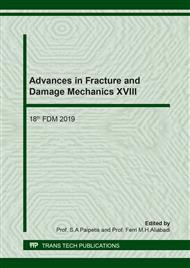p.240
p.246
p.252
p.258
p.263
p.269
p.275
p.282
p.288
Computational Multi-Scale Modelling of Fiber-Reinforced Composite Materials
Abstract:
A cross-ply fiber-reinforced composite in uniaxial tension is modelled using a mesoscale and a micro-scale approach comparing the results from both the analyses. The use of multi-scale modelling gives directly the macroscopic constitutive behaviour of the structures based on its microscopically heterogeneous representative volume element (RVE). In the meso-scale approach the material of each layer is modelled as a homogeneous transversely isotropic material whose properties resulted from a numerical homogenization analysis. One of the main advantages of micro-scale modelling is the ability to simulate damage mechanisms such as matrix cracking, delaminations of the matrix-fiber interface and fibre-damage. In the first part of this study, analytical and numerical homogenization schemes are compared. RVEs of continuous fibre and short-fibre reinforced composites are created, homogenized numerically and compared with the widespread analytical scheme of Mori-Tanaka based on Eshelby’s solution of the single inclusion problem. In the second part, results’ comparison between the simulations of both scales is performed. In the meso-scale model stochasticity has been introduced, assigning interfacial strength following a normal distribution, in order to predict cracking initiation, propagation and saturation at the matrix material. The stresses at the crack tips are compared with the stress fields around the cracks from the micro-scale analysis and the results are in good agreement.
Info:
Periodical:
Pages:
263-268
Citation:
Online since:
December 2019
Price:
Сopyright:
© 2020 Trans Tech Publications Ltd. All Rights Reserved
Share:
Citation:


